Recently I have added three new pocket-sized squares to my tool kit, or more precisely, pocket, to join a pair of old favorites. Okay, not literally in my pocket, except for one of them that does actually reside in my hip pocket when I am in the shop, but all four have become integral to my work.
I am a fan of the Speed Square concept and have a number of them scattered around my work spaces, whether in the barn, in the cabin, or in the workshops at my daughters’ houses. 12-inch model, 6-inch model, grey plastic, orange plastic, aluminum, I’ve got them and use them constantly. Were I to actually read the instruction booklets carefully I suppose I could use them to get to the Moon.
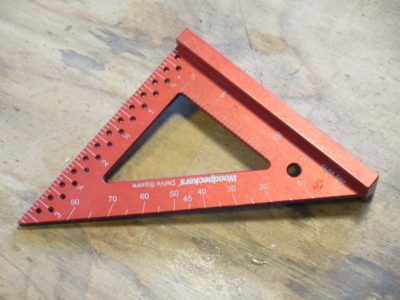
My only wish regarding them was that there was a smaller version, one that I could fit easily in my hip pocket or apron pocket so that it was never out of reach. Well, my friend Tom Delvecchio did just that for Woodpecker’s with their one-time tool “The Delve Square” which was, true to their marketing, a limited production tool. When it first came out I bookmarked it fully intending to go back and purchase it, but as is too often the case I got distracted by other things and by the time I got back to it they were sold out. At this year’s Groopshop Tom donated one of these tools for the fundraiser auction and the bidding was, shall we say, spirited. I finally dropped out at about twice the original sales price. Imagine my surprise when a package from Tom arrived a fortnight later, and inside was a Delve Square he had arranged for me to receive. As I wrote him immediately, no good deed goes unpunished and I will bestow some equal generosity on him as time goes by.

And yes, I really do carry it in my hip pocket pretty much all the time when I am in the shop.
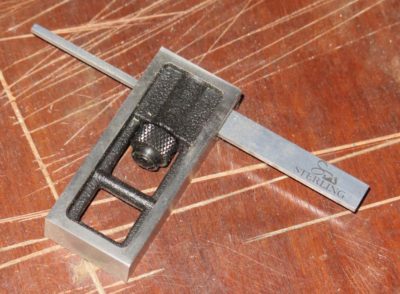
My second new ingenious addition is the Sterling Tool Works’ Dovetail Square. Many electrons have been expended on its behalf in the woodworking blogoshpere so I will not extol it in-depth here, but this tool has remained on my bench top ever since I got it. I have yet to even put it away, it gets used so much!

Combined with my new petite dovetail saw from Bad Axe, my dovetailing has become not so much better but rather more important, much faster, especially when combined with my long-time friend, the dovetail layout square I fashioned from a piece of 1″ aluminum angle bar stock. I have seen and used a wide variety of dovetail gauges over the years, but this 5-cent version made on the table saw from my own scrap drawer contents remains my favorite.
Actually I made two versions, one for shallower angled dovetails, the other for steeper. I did not quantify the angles, I just made them to the angles I thought looked right. The red layout dye is apparently left over from some earlier project unrelated to the dovetail squares, but I have not found it to be a hindrance to the tools’ performance.
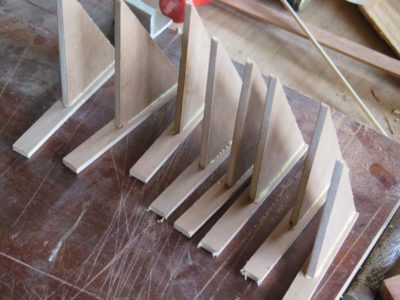
In addition to the need for the functions of these squares I find that between my growing commitment to making both the Roubo workbench and classical parquetry a square with 30-60-90 functions is ever more prominent for my work. So this week I made several to have on hand and to send to students who requested it.
Delving into my scrap box once again I pulled out a piece of 1/4 plywood and made them.

After ripping the piece to about five inches and squaring the ends I brought out my old triangle that dates from the times I actually did drafting and this was part of that tool kit. With the miter gauge on the table saw set to perfectly square, I laid the triangle against it then tucked a corner of the plywood piece into the kerf cut into the miter gauge.
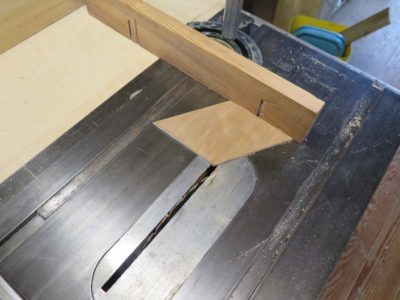
I cut the resultant triangle from each end of the plywood piece, then removed my drafting triangle and cut off two more.
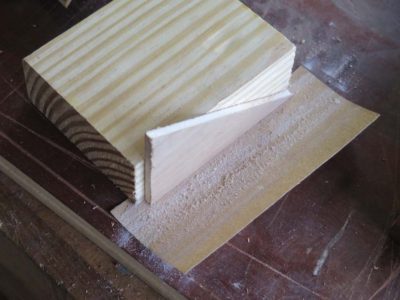
I trued the edges of the sawn triangles with a squared block and a piece of fine sandpaper, glued a shelf on to the base of the triangle, cleaned up the excess glue, and they were done.
Among the 12,461 noteworthy things I was reminded of when undertaking our final review of Roubo on Furniture Making this week, in preparation for its release later this autumn from Lost Art Press:
It would be easy to convince oneself of what I am advancing here, if one wishes to note that the Art of Joinery is, without question, the most extensive of the mechanical Arts, for both the different types of Joinery and the multitude of works belonging to each type of Joinery, which requires a quantity of knowledge distinct one from the other. Such that the Art of Joinery can and should even be regarded as six Arts under the same name, but all different from each other. Namely, the Art of Building Carpentry, which is quite considerable, the Art of Carriage Woodworking; the Art of Furniture Making, which is separated in two distinct classes one from the other, the Art of Cabinetry, which embraces not only the knowledge of choice and use of wood, but also that of different metals and other substances both mineral and vegetable, and the use even of turning and filing; the Art of Trelliswork or Garden Woodworking, which is still another class apart, without counting the Art of Drawing, necessary for various sorts of Joinery, the detail of which has been made the object of more than half of the second Part of this Work. This observation is altogether natural – it is the only Art that, under the same name, [that] has rapport with [connection to] so many different objects. With the exception of Carpentry, the Art of Joinery embraces all which has to do with the use of wood, instead of those Arts that have for its object the use of metals, taking different names, although using the same material. Because, without speaking of the use of Mines and iron Forges, the Workers which use this metal, are known under different names, like the Blacksmiths of two types, the Locksmiths also of two types, the Maker of Edge-Tools, the Tinsmiths, the Cutlers, the Nailsmiths, and even the Clockmakers, those who make mathematical Instruments, and a number of others who do completely separate Arts, distinct one from the others. Their their description, if they be united in a single and same Art, would contain more than 10 to 12 volumes, assuming that they are treated according to the intentions of the Royal Academy of Sciences, that is to say, with the precision and all the appropriate extent for each of them.
J.A. Roubo, l’Art du Menuisier, page 760 footnote.

What it was like outside yesterday.

What was happening inside yesterday.
In the interest of full disclosure I must admit that we took our Roubo Review Extravaganza out onto the front porch for a while, but the grind of reviewing 434 pages of book proofs is still a, well, grind. Pray that my voice holds out for the duration as I read aloud every word and typesetting feature of the page proofs while Michele runs alongside in the original. We’re somewhere around page 120, ready to resume work as soon as we finish breakfast.
Alas, another gorgeous day outside.

During our recent workbench-building event at The Barn BillR opted to build two small benches instead of one large bench. This was due in great part to the spatial limitations of his work space, and he managed to create something(s) very special from the seeming hurdle.


I’ve already written about the larger of the two with its Emmert K2 vise, but equally captivating was his much smaller bench made from the same stock and using the identical techniques as the larger benches built that week. Admittedly I helped him a bit with the second one once I made sure that everyone else was on-track with their large benches.
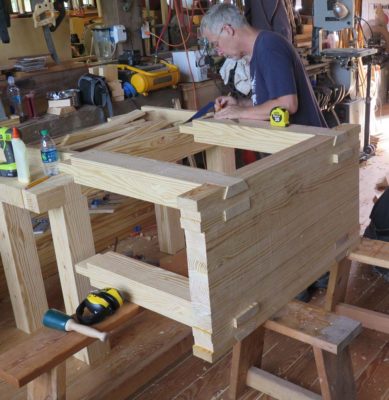
Bill reports that the final dimensions for the two benches were 54 1/2″ long by 23 1/4″ wide by 35 1/2″ tall for the larger of the two and 41″ long by 23 1/4″ wide by 30″ tall for the smaller bench. It could literally make a nesting pair with the larger bench. We kidded him about the smaller bench and immediately dubbed it “The Hobbit-Sized Roubo” a/k/a/ “The Bill-bo.”
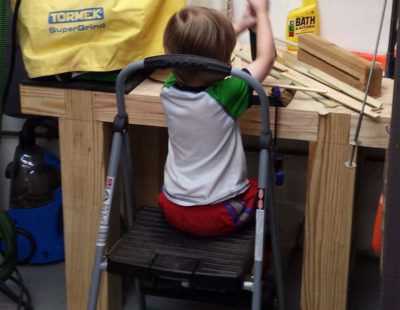
He reports that it is right at home in his space, and in addition to being exceedingly sturdy has the added feature of being easily disassembled and transported to his remote retreat in the U.P. Plus it is a near-perfect fit for a grandson.


















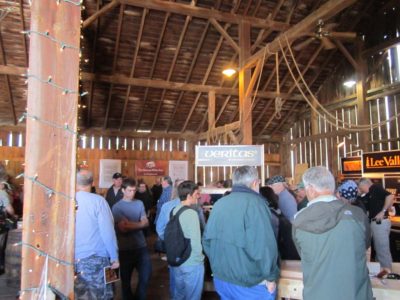
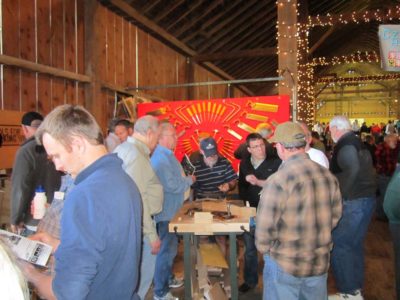


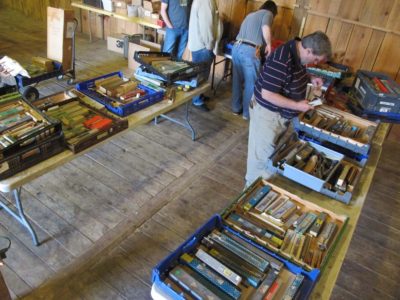


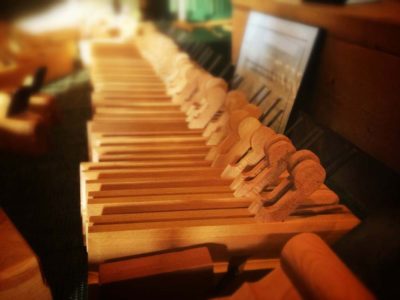


Recent Comments